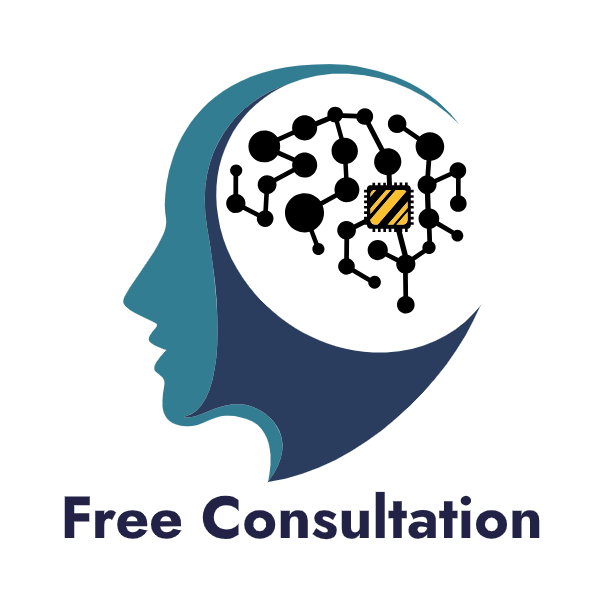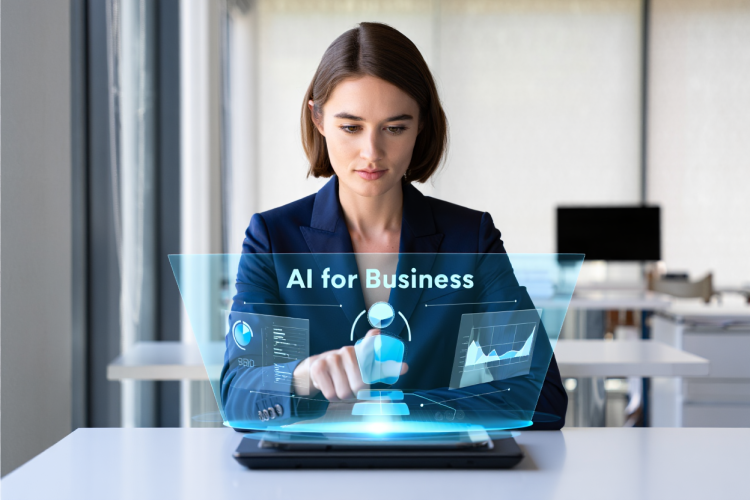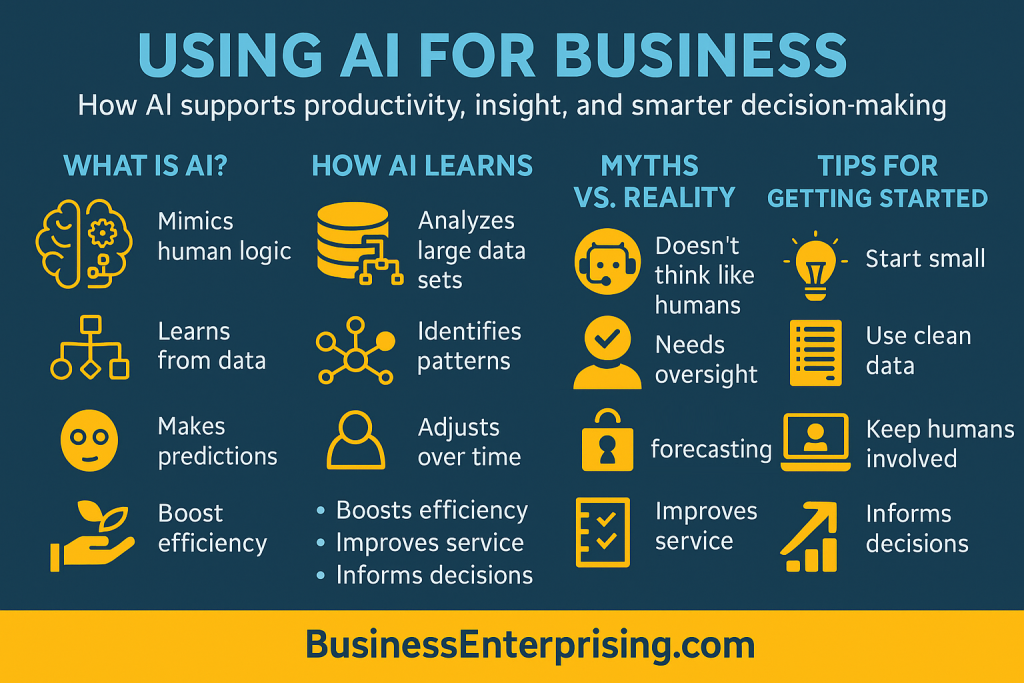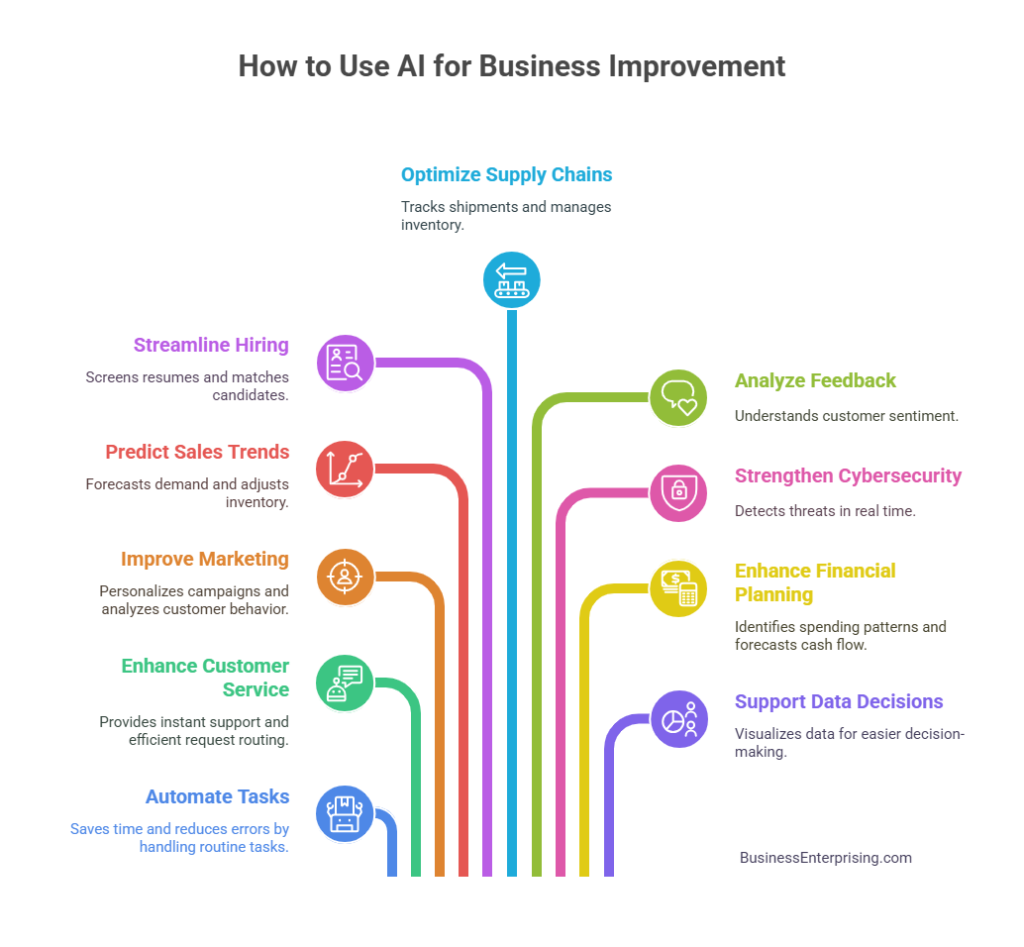
Also, business owners often ask if AI will replace their teams or create risks. These are fair concerns, but the reality is more balanced. AI assists with tasks, but it doesn’t replace human insight or decision-making. Therefore, learning what AI can and can’t do puts you in control. You’ll use it with more confidence and clarity. The goal is to apply it where it helps—not to change everything overnight.
You don’t need advanced tech skills to get started. Many tools are easy to use and designed for real-world problems. The more you know about AI, the easier it becomes to find ways it can support your goals. AI is here, and it’s practical. With the right approach, it becomes a tool that works with you—not against you.
What is artificial intelligence (AI)?
AI is the development of computer systems that can perform tasks typically requiring human intelligence, such as learning and problem-solving.
Artificial intelligence, or AI, refers to systems that mimic human thinking to complete tasks like learning, analyzing, and making decisions. You interact with AI more often than you may realize. It helps sort your emails, recommend products, and even answer customer service questions. Additionally, AI is based on data and pattern recognition. These systems learn by processing information and adjusting their responses based on what they observe. Therefore, the more data they receive, the more accurate and useful they can become. This learning process sets AI apart from traditional software.
However, AI doesn’t think like a person. It follows patterns and rules but doesn’t understand emotion or context the way you do. Despite that, it can outperform humans in speed and accuracy when analyzing large amounts of data. Using AI for business can improve efficiency and save time. You can automate repetitive tasks, improve customer interactions, and get insights faster. As a result, your team can focus on higher-level work that requires judgment and creativity.
Also, AI can help with forecasting, lead generation, and decision-making. It won’t replace your team, but it can support them in meaningful ways. Therefore, it’s worth exploring how AI tools can fit into your current processes. You don’t need to be a tech expert to benefit from AI. Start small and build from there. By learning what these systems can do, you position your business to grow smarter and operate more effectively.
How does AI learn?
AI learns by analyzing large amounts of data and identifying patterns to make predictions or decisions based on that data.
AI learns by processing large amounts of data to find patterns and relationships between variables. It doesn’t rely on hard-coded rules. Instead, it uses algorithms that adjust based on the data it receives. This process is called machine learning. Additionally, AI improves over time. The more data you feed it, the better it becomes at predicting outcomes or making decisions. Therefore, results typically improve as the system gathers experience through new inputs. However, AI doesn’t learn like humans. It lacks understanding or awareness. It identifies trends and probabilities, not meaning or context. As a result, it can still make errors when the data is flawed or incomplete.
Using AI for business starts with training the system on your specific data. For example, you might input customer interactions to help an AI tool identify common questions. It can then suggest or automate responses. This reduces manual work and speeds up service. Also, AI models need regular updates. As your data changes, the system must adjust. Therefore, plan to review and retrain it to keep results accurate.
The key to effective learning is quality data. If the data is biased or inconsistent, the system will reflect that. You must understand what information the AI is using and how it influences outcomes. By understanding how AI learns, you can better apply it to your business. With clear goals and solid data, it becomes a helpful tool for saving time, improving service, and making faster decisions.
Is AI going to replace human jobs?
AI may automate some tasks, but it also creates new roles and opportunities that still require human skills and oversight.
Many people worry that AI will take over jobs and leave fewer opportunities for workers. This concern is understandable but not absolute. While AI does automate certain tasks, it also creates new roles that require human input and decision-making. In addition, AI performs best when handling repetitive or data-heavy tasks. These are things like sorting emails, processing invoices, or analyzing trends. Therefore, it often replaces steps in a process—not the entire job. However, people still play a major role. AI can’t replace empathy, critical thinking, or complex communication. These human traits remain essential in areas like leadership, customer service, and creative work. As a result, jobs are shifting—not disappearing.
Using AI for business often leads to a blend of automation and human oversight. You may find your team spends less time on routine work and more time on strategy. This improves both efficiency and job satisfaction. Also, AI brings new career paths. Roles in data analysis, AI training, and system management are growing fast. Therefore, those who adapt gain more opportunities, not fewer.
You should focus on how AI fits into your workflows—not how it replaces them. When people and machines work together, output improves without sacrificing quality or insight. AI will change how work is done. But with thoughtful use, it adds support—not competition—to your team.
Can AI think like a human?
No, AI can simulate human behavior but lacks consciousness, emotions, and true understanding.
AI may seem smart, but it doesn’t think like you do. It processes data, follows patterns, and generates responses based on rules. However, it doesn’t understand meaning the way people do. It can’t feel emotions, form opinions, or apply real-world judgment. Additionally, AI lacks self-awareness. It doesn’t have personal experiences or goals. Therefore, it can’t make choices based on values or emotional context. You may interact with AI that sounds human, but it’s only mimicking patterns from past input.
Also, AI doesn’t truly learn in the human sense. It updates based on data, not understanding. You could say it reacts, but it doesn’t reason. As a result, AI can repeat errors if the data it receives is biased or incomplete. Using AI for business works best when you treat it as a tool—not a replacement for human thinking. It helps with speed, efficiency, and routine analysis. However, it still needs your direction, review, and final judgment.
Therefore, trust AI to assist, but not to decide for you. Keep people involved in planning, reviewing, and refining what the system produces. This balance keeps your output useful, accurate, and aligned with your goals. You don’t need AI to think like you. You just need it to help you work smarter. That’s where it brings the most value to your business.
Is AI safe to use?
AI is generally safe when designed responsibly, but it requires careful regulation and oversight to prevent misuse or bias.
AI is generally safe when used with the right structure and purpose. It follows clear instructions and doesn’t act on its own. However, problems can arise when it’s poorly designed or used without proper review. Like any tool, the way you apply it matters. Additionally, AI can reflect the biases in its training data. If the input is flawed, the output may also be unfair or inaccurate. Therefore, you must understand what data your system is using and how it affects results. Responsible use starts with transparency and testing. Also, AI systems need human oversight. They can misinterpret context, overlook key details, or miss ethical concerns. As a result, decisions should never rely fully on automation. You need checks in place to catch mistakes and assess impact.
Using AI for business works best when you focus on clear goals, accurate data, and accountability. These systems can help you save time and improve service. However, you remain responsible for the outcomes. Therefore, treat AI as a support system—not a final authority. Review its recommendations, involve your team, and update your processes as needed. This keeps your use of AI practical and safe.
You don’t need to fear AI. But you do need to use it thoughtfully. When applied with care, it can help your business run more smoothly and make better decisions.
How is AI used in everyday life?
AI powers common tools like virtual assistants, recommendation systems, spam filters, and facial recognition in smartphones and apps.
You probably use AI more often than you realize. It helps filter your emails, recommend shows, and even unlock your phone. These tools rely on AI to recognize patterns and respond in real time. However, they work quietly in the background, so you may not notice. Additionally, virtual assistants like the ones on your phone or smart speaker use AI to process voice commands. They answer questions, set reminders, and manage tasks with simple voice input. Therefore, they save time and help you stay organized with minimal effort.
Also, facial recognition uses AI to match your face with stored images. It allows you to log in to apps, verify identity, or access devices. This technology analyzes key features of your face without storing personal thoughts or emotions. Using AI for business builds on these same concepts. If AI can help you at home, it can help streamline tasks at work too. For example, it can analyze customer data, improve support chats, or suggest next steps in a project.
Therefore, you don’t need advanced tools to benefit from AI. Many of the apps and services you already use rely on it. By recognizing how AI works in everyday life, you’ll feel more confident applying it at work. The goal isn’t to replace people. It’s to simplify repetitive tasks and provide useful insights. AI makes life more efficient by doing what it does best—analyzing data quickly and acting on patterns.
Conclusion
Artificial intelligence is already part of your daily life. It supports your devices, improves your searches, and simplifies routine tasks. However, understanding how it works helps you use it more effectively and responsibly. You don’t need to be an expert to benefit from its features. Additionally, AI is not meant to think like you. It follows logic, not emotion. Therefore, it works best when paired with your judgment and creativity. While it may automate some tasks, it also creates room for new roles and responsibilities.
Using AI for business should focus on support, not replacement. When used correctly, it saves time, improves decision-making, and strengthens service. However, it requires oversight to prevent mistakes, misuse, or bias. Keep people involved in key decisions to guide outcomes.
Also, consider how AI fits your current needs. Start with simple applications that support your team and goals. Then, expand as you gain experience and trust in the tools.
Therefore, stay curious and continue learning. AI will keep evolving, and so will the ways it can help your work. By staying involved and informed, you’ll use AI in ways that support long-term progress without sacrificing control. AI can be a helpful part of your business toolkit. With careful use, it improves how you work—not just how much you get done.



